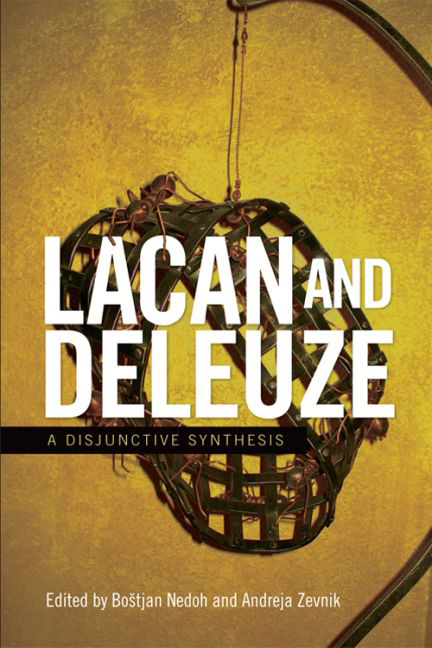Book contents
- Frontmatter
- Contents
- Acknowledgements
- Introduction: On a Disjunctive Synthesis between Lacan and Deleuze
- 1 For Another Lacan-Deleuze Encounter
- 2 Reciprocal Portrait of Jacques Lacan in Gilles Deleuze
- 3 Does the Body without Organs Have Any Sex at All? Lacan and Deleuze on Perversion and Sexual Difference
- 4 Gnomonology: Deleuze's Phobias and the Line of Flight between Speech and the Body
- 5 Lacan, Deleuze and the Politics of the Face
- 6 Denkwunderkeiten: On Deleuze, Schreber and Freud
- 7 Snark, Jabberwock, Poord'jeli: Deleuze and the Lacanian School on the Names-of-the-Father
- 8 Baroque Structuralism: Deleuze, Lacan and the Critique of Linguistics
- 9 Exalted Obscenity and the Lawyer of God: Lacan, Deleuze and the Baroque
- 10 The Death Drive
- 11 Repetition and Difference: Žižek, Deleuze and Lacanian Drives
- 12 Lacan, Deleuze and the Consequences of Formalism
- Notes on Contributors
- Index
4 - Gnomonology: Deleuze's Phobias and the Line of Flight between Speech and the Body
Published online by Cambridge University Press: 20 April 2017
- Frontmatter
- Contents
- Acknowledgements
- Introduction: On a Disjunctive Synthesis between Lacan and Deleuze
- 1 For Another Lacan-Deleuze Encounter
- 2 Reciprocal Portrait of Jacques Lacan in Gilles Deleuze
- 3 Does the Body without Organs Have Any Sex at All? Lacan and Deleuze on Perversion and Sexual Difference
- 4 Gnomonology: Deleuze's Phobias and the Line of Flight between Speech and the Body
- 5 Lacan, Deleuze and the Politics of the Face
- 6 Denkwunderkeiten: On Deleuze, Schreber and Freud
- 7 Snark, Jabberwock, Poord'jeli: Deleuze and the Lacanian School on the Names-of-the-Father
- 8 Baroque Structuralism: Deleuze, Lacan and the Critique of Linguistics
- 9 Exalted Obscenity and the Lawyer of God: Lacan, Deleuze and the Baroque
- 10 The Death Drive
- 11 Repetition and Difference: Žižek, Deleuze and Lacanian Drives
- 12 Lacan, Deleuze and the Consequences of Formalism
- Notes on Contributors
- Index
Summary
We must define a special function, which is identical to neither health nor illness: the function of the Anomalous. The Anomalous is always at the frontier […] it traces a line-between […] This is the Thing or Entity of terror.
Gilles Deleuze, Dialogues IILet us recognise […] the subject's efficacy in the gnomon he erects, a gnomon that constantly indicates truth's site to him.
Jacques Lacan, ÉcritsØóβcς
As Brian Massumi remarks in his notes to the translation of A Thousand Plateaus, the word ‘flight’ does not quite convey everything at stake in the notion of ‘ligne de fuite’ that has ‘a different range of meanings’. For example, it has less to do with the act of flying than with that of fleeing, making an exit or vanishing. The English word flight can also mean flee, of course, as in the flight from some object of fear, or in the act of putting-to-flight. A line, meanwhile, is not just something along which one might travel, but can also function as a frontier that differentiates or separates two planes, fields or territories. Let us say between Lacan and Deleuze, for example, or even Deleuze and Guattari. No doubt we can regard these proper names as designating certain zones or discursive fields of philosophy and analysis as well as authors. At the same time there is also the question of the relation between the author and his or her work. The significant term that is highlighted by the ‘line of flight’, however, is neither of the proper names but the ‘and’ that marks the borderline between the two. As Deleuze writes, ‘AND is neither one thing nor the other, it's always in-between, between two things … there's always a border, a line of flight or flow, only we don't see it because it's the least perceptible of things’. The ‘and’ is imperceptible, or rather overlooked because it is there on the surface, as plain as day, the word that links and separates a couple or a concatenation of elements. Clearly, given the various meanings of the ‘ligne de fuite’, ‘and’ does not denote a harmonious unity like ying and yang, say, but a multiplicity that may well be discordant in its conjunctive parts, a disjunctive synthesis perhaps.
- Type
- Chapter
- Information
- Lacan and DeleuzeA Disjunctive Synthesis, pp. 56 - 73Publisher: Edinburgh University PressPrint publication year: 2017



